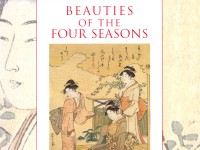Beauties of the Four Seasons
A full catalogue of the Ashmolean’s collection of Japanese bijinga (beautiful women) prints by Mitsuko Watanabe (published Oxford, 2005).

Publications online: 54 objects
The courtesan Madoka of the Tamaya Brothel with two attendants
-
Literature notes
The Series is thought to contain only two prints and this print is one of the last works by Utamaro. The other is The Courtesan Shi-ratama of the Tamaya-nai.
Madoka, an oiran, stands in the centre looking to her left, with a shinzō (lower rank) on her right. The kamuro on her left are in pink and purple kimono. The outer garment of Madoka bears a representation of ryūsui-kakitsubata (design of the river flowing between clumps of iris) and her obi has a beautiful design, circular, in black and gold with more regular circles of the same colours below. The shinzō’s garment has the kanze-mizu. (water-ripple design) pattern. Madoka’s kimono seems to be for the cold season, possibly late autumn or winter, with cotton padding placed between each layer of fabric. -
Details
- Series
- Array of Blooms in the Flower Beds at the New Quarters
- Associated place
- Date
- c. 1800
- Artist/maker
-
Kitagawa Utamaro (c. 1753 - 1806) (designer)
- Associated people
-
Tsuruya Kiemon (c. 1720 - 1875) (publisher)Madoka Tamaya (late 18th century - early 19th century) (subject)Hagino はぎの (late 18th century - early 19th century) (subject)Ogino (late 18th century - early 19th century) (subject)
- Material and technique
- nishiki-e (multi-block) woodblock print, printed with water-based vegetable pigments
- Dimensions
-
mount 55.5 x 40.5 cm (height x width)
sheet 39.5 x 27 cm (height x width)
print 39 x 25.2 cm (height x width)
- Material index
- Technique index
- Object type index
- No. of items
- 1
- Credit line
- Presented by Mrs Allan and Mr and Mrs H. N. Spalding, 1952.
- Accession no.
- EAX.4779
-
Further reading
Oxford: Ashmolean Museum, 24 August-30 November 2005, Beauties of the Four Seasons, Mitsuko Watanabe, ed. (Oxford: Ashmolean Museum, 2005), no. 17 on p. 34, illus. p. 35
Glossary (2)
nishiki-e, vegetable pigments
-
nishiki-e
Nishiki-e literally means 'brocade pictures' and refers to multi-coloured woodblock prints.
-
vegetable pigments
Vegetable pigments were used to create coloured dyes for Japanese prints, paintings, and textiles. These pigments often faded over time due to the chemical reactions they underwent.
Location
-
- currently in research collection
Objects are sometimes moved to a different location. Our object location data is usually updated on a monthly basis. Contact the Jameel Study Centre if you are planning to visit the museum to see a particular object on display, or would like to arrange an appointment to see an object in our reserve collections.
Publications online
-

Beauties of the Four Seasons
The Series is thought to contain only two prints and this print is one of the last works by Utamaro. The other is The Courtesan Shi-ratama of the Tamaya-nai.
Madoka, an oiran, stands in the centre looking to her left, with a shinzō (lower rank) on her right. The kamuro on her left are in pink and purple kimono. The outer garment of Madoka bears a representation of ryūsui-kakitsubata (design of the river flowing between clumps of iris) and her obi has a beautiful design, circular, in black and gold with more regular circles of the same colours below. The shinzō’s garment has the kanze-mizu. (water-ripple design) pattern. Madoka’s kimono seems to be for the cold season, possibly late autumn or winter, with cotton padding placed between each layer of fabric.
Notice
Object information may not accurately reflect the actual contents of the original publication, since our online objects contain current information held in our collections database. Click on 'buy this publication' to purchase printed versions of our online publications, where available, or contact the Jameel Study Centre to arrange access to books on our collections that are now out of print.
© 2013 University of Oxford - Ashmolean Museum

